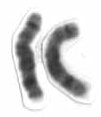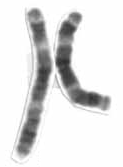Related Research Articles

In genetics, a deletion is a mutation in which a part of a chromosome or a sequence of DNA is left out during DNA replication. Any number of nucleotides can be deleted, from a single base to an entire piece of chromosome. Some chromosomes have fragile spots where breaks occur, which result in the deletion of a part of the chromosome. The breaks can be induced by heat, viruses, radiation, or chemical reactions. When a chromosome breaks, if a part of it is deleted or lost, the missing piece of chromosome is referred to as a deletion or a deficiency.
Gene duplication is a major mechanism through which new genetic material is generated during molecular evolution. It can be defined as any duplication of a region of DNA that contains a gene. Gene duplications can arise as products of several types of errors in DNA replication and repair machinery as well as through fortuitous capture by selfish genetic elements. Common sources of gene duplications include ectopic recombination, retrotransposition event, aneuploidy, polyploidy, and replication slippage.
Gene conversion is the process by which one DNA sequence replaces a homologous sequence such that the sequences become identical after the conversion event. Gene conversion can be either allelic, meaning that one allele of the same gene replaces another allele, or ectopic, meaning that one paralogous DNA sequence converts another.

Haploinsufficiency in genetics describes a model of dominant gene action in diploid organisms, in which a single copy of the wild-type allele at a locus in heterozygous combination with a variant allele is insufficient to produce the wild-type phenotype. Haploinsufficiency may arise from a de novo or inherited loss-of-function mutation in the variant allele, such that it yields little or no gene product. Although the other, standard allele still produces the standard amount of product, the total product is insufficient to produce the standard phenotype. This heterozygous genotype may result in a non- or sub-standard, deleterious, and (or) disease phenotype. Haploinsufficiency is the standard explanation for dominant deleterious alleles.

Copy number variation (CNV) is a phenomenon in which sections of the genome are repeated and the number of repeats in the genome varies between individuals. Copy number variation is a type of structural variation: specifically, it is a type of duplication or deletion event that affects a considerable number of base pairs. Approximately two-thirds of the entire human genome may be composed of repeats and 4.8–9.5% of the human genome can be classified as copy number variations. In mammals, copy number variations play an important role in generating necessary variation in the population as well as disease phenotype.

Medical genetics is the branch of medicine that involves the diagnosis and management of hereditary disorders. Medical genetics differs from human genetics in that human genetics is a field of scientific research that may or may not apply to medicine, while medical genetics refers to the application of genetics to medical care. For example, research on the causes and inheritance of genetic disorders would be considered within both human genetics and medical genetics, while the diagnosis, management, and counselling people with genetic disorders would be considered part of medical genetics.

A gene family is a set of homologous genes within one organism. A gene cluster is a group of two or more genes found within an organism's DNA that encode similar polypeptides, or proteins, which collectively share a generalized function and are often located within a few thousand base pairs of each other. The size of gene clusters can vary significantly, from a few genes to several hundred genes. Portions of the DNA sequence of each gene within a gene cluster are found to be identical; however, the resulting protein of each gene is distinctive from the resulting protein of another gene within the cluster. Genes found in a gene cluster may be observed near one another on the same chromosome or on different, but homologous chromosomes. An example of a gene cluster is the Hox gene, which is made up of eight genes and is part of the Homeobox gene family.
NUMT, pronounced "new might", is an acronym for "nuclear mitochondrial DNA" segments or genetic loci coined by evolutionary geneticist, Jose V. Lopez, which describes a transposition of any type of cytoplasmic mitochondrial DNA into the nuclear genome of eukaryotic organisms.

Arf-GAP with dual PH domain-containing protein 2 is a protein that in humans is encoded by the ADAP2 gene.

Gene redundancy is the existence of multiple genes in the genome of an organism that perform the same function. Gene redundancy can result from gene duplication. Such duplication events are responsible for many sets of paralogous genes. When an individual gene in such a set is disrupted by mutation or targeted knockout, there can be little effect on phenotype as a result of gene redundancy, whereas the effect is large for the knockout of a gene with only one copy. Gene knockout is a method utilized in some studies aiming to characterize the maintenance and fitness effects functional overlap.
Low copy repeats (LCRs), also known as segmental duplications (SDs), are DNA sequences present in multiple locations within a genome that share high levels of sequence identity.
Potocki–Lupski syndrome (PTLS), also known as dup(17)p11.2p11.2 syndrome, trisomy 17p11.2 or duplication 17p11.2 syndrome, is a contiguous gene syndrome involving the microduplication of band 11.2 on the short arm of human chromosome 17 (17p11.2). The duplication was first described as a case study in 1996. In 2000, the first study of the disease was released, and in 2007, enough patients had been gathered to complete a comprehensive study and give it a detailed clinical description. PTLS is named for two researchers involved in the latter phases, Drs. Lorraine Potocki and James R. Lupski of Baylor College of Medicine.

Koolen–De Vries syndrome (KdVS), also known as 17q21.31 microdeletion syndrome, is a rare genetic disorder caused by a deletion of a segment of chromosome 17 which contains six genes. This deletion syndrome was discovered independently in 2006 by three different research groups.
DECIPHER is a web-based resource and database of genomic variation data from analysis of patient DNA. It documents submicroscopic chromosome abnormalities and pathogenic sequence variants, from over 25000 patients and maps them to the human genome using Ensembl or UCSC Genome Browser. In addition it catalogues the clinical characteristics from each patient and maintains a database of microdeletion/duplication syndromes, together with links to relevant scientific reports and support groups.

8p23.1 duplication syndrome is a rare genetic disorder caused by a duplication of a region from human chromosome 8. This duplication syndrome has an estimated prevalence of 1 in 64,000 births and is the reciprocal of the 8p23.1 deletion syndrome. The 8p23.1 duplication is associated with a variable phenotype including one or more of speech delay, developmental delay, mild dysmorphism, with prominent forehead and arched eyebrows, and congenital heart disease (CHD).

3q29 microdeletion syndrome is a rare genetic disorder resulting from the deletion of a segment of chromosome 3. This syndrome was first described in 2005.
1q21.1 deletion syndrome is a rare aberration of chromosome 1. A human cell has one pair of identical chromosomes on chromosome 1. With the 1q21.1 deletion syndrome, one chromosome of the pair is not complete, because a part of the sequence of the chromosome is missing. One chromosome has the normal length and the other is too short.

1q21.1 duplication syndrome or 1q21.1 (recurrent) microduplication is a rare aberration of chromosome 1.
22q11.2 duplication syndrome is a rare genetic disorder caused by a duplication of a segment at the end of chromosome 22.
Genome instability refers to a high frequency of mutations within the genome of a cellular lineage. These mutations can include changes in nucleic acid sequences, chromosomal rearrangements or aneuploidy. Genome instability does occur in bacteria. In multicellular organisms genome instability is central to carcinogenesis, and in humans it is also a factor in some neurodegenerative diseases such as amyotrophic lateral sclerosis or the neuromuscular disease myotonic dystrophy.
References
- 1 2 Hurles, Matthew; et al. (2006), "Recombination Hotspots in Nonallelic Homologous Recombination", Genomic Disorders: The Genomic Basis of Disease, Humana Press, pp. 341–355[ permanent dead link ]
- ↑ Beckmann JS, Estivill X, Antonarakis SE (August 2007). "Copy number variants and genetic traits: closer to the resolution of phenotypic to genotypic variability". Nat. Rev. Genet. 8 (8): 639–46. doi:10.1038/nrg2149. PMID 17637735. S2CID 32906877.
- ↑ Colnaghi, Rita (July 2011). "The consequences of structural genomic alterations in humans: Genomic Disorders, genomic instability and cancer". Seminars in Cell & Developmental Biology. 22 (8): 875–885. doi:10.1016/j.semcdb.2011.07.010. PMID 21802523.
- 1 2 3 Colnaghi, Rita; Carpenter, Gillian; Volker, Marcel; O’Driscoll, Mark (2011-10-01). "The consequences of structural genomic alterations in humans: Genomic Disorders, genomic instability and cancer". Seminars in Cell & Developmental Biology. Polarized growth and movement: How to generate new shapes and structuresChromosome Recombination. 22 (8): 875–885. doi:10.1016/j.semcdb.2011.07.010. PMID 21802523.
- ↑ Karn RC, Laukaitis CM (2009). "The mechanism of expansion and the volatility it created in three pheromone gene clusters in the mouse (Mus musculus) genome". Genome Biol Evol. 1: 494–503. doi:10.1093/gbe/evp049. PMC 2839280 . PMID 20333217.
- ↑ Venturin M, Gervasini C, Orzan F, et al. (June 2004). "Evidence for non-homologous end joining and non-allelic homologous recombination in atypical NF1 microdeletions". Hum. Genet. 115 (1): 69–80. doi:10.1007/s00439-004-1101-2. PMID 15103551. S2CID 22263143.
- ↑ Koolen DA, Sharp AJ, Hurst JA, et al. (November 2008). "Clinical and molecular delineation of the 17q21.31 microdeletion syndrome". J. Med. Genet. 45 (11): 710–20. doi:10.1136/jmg.2008.058701. PMC 3071570 . PMID 18628315.
- ↑ Willatt L, Cox J, Barber J, et al. (July 2005). "3q29 microdeletion syndrome: clinical and molecular characterization of a new syndrome". Am. J. Hum. Genet. 77 (1): 154–60. doi:10.1086/431653. PMC 1226188 . PMID 15918153.